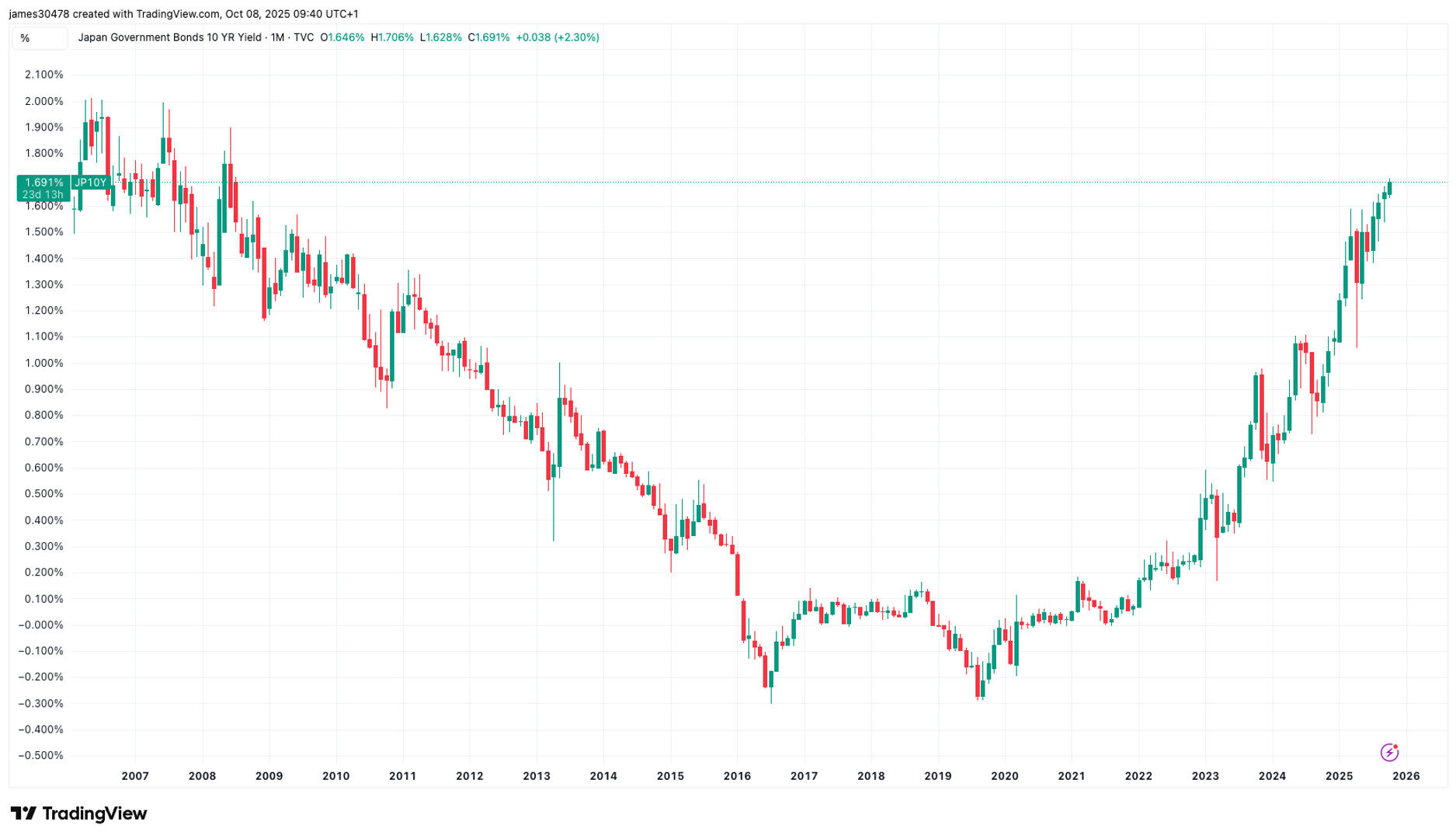The hardening of Japanese government bond yields could spillover into other sovereign bond markets, capping upside in risk assets, including BTC.
By James Van Straten, Omkar Godbole|Edited by Omkar Godbole
Oct 8, 2025, 9:22 a.m.

- Bitcoin remains under pressure as Japanese bond yields rise.
- Goldman Sachs fears that hardening of Japanese yields could raise borrowing costs across the advanced world.
- The dollar index is rising, with the yen depreciating against the greenback.
A lot can change in just a few days. Bitcoin recently reached new all-time highs of over in both U.S. dollar and Japanese yen terms, boosted by new Japanese prime minister, Takaichi Sanae‘s bias for ultra-easy Abenomics policy setting.
However, the very same Abenomics bias now seems to be working against BTC through its impact on the bond market.
STORY CONTINUES BELOW
One of the key features of Abenomics is the implementation of an expansionary fiscal policy, characterised by increased government spending to support economic growth. In other words, bond supply could increase, worsening the already dour fiscal outlook.
The Japanese government bonds seem to be pricing that, pushing yields higher. (bond prices and yields move in the opposite direction). According to TradingEconomics, the 10-year JGB yield hit a high of 1.70% early Wednesday, the highest since July 2008. It has risen by 13.31 basis points in one week and over 76 basis points in 12 months. The 30-year yield rose to 3.34% and quickly fell back to 3.16%.
Rising bond yields typically zap investor risk appetite as they increase the cost of borrowing, denting the appeal of riskier assets such as stocks and cryptocurrencies. Some analysts view bitcoin as both a risk asset and a digital form of gold, although historically data shows that the cryptocurrency tends to track tech stocks more closely.
The upswing in JGB yield is even more concerning, considering its impact on the global bonds. According to Goldman Sachs, volatility in Japanese bonds could spill over into Treasury notes, adding to market jitters.
For every 10 basis point “idiosyncratic JGB (Japanese government bond) shock,” investors can expect around two to three basis points of upward pressure on U.S., German and U.K. yields, strategists at Goldman Sachs said in a recent market note, according to Bloomberg.
The dollar index has climbed to a two-month high and the move is likely being led by the depreciation in the Japanese yen, which has dropped 3.5% against the USD since Friday.
The JPY’s decline is also linked to Abenomics, which calls for low interest rates at home. The probability of a Bank of Japan (BoJ) rate hike this month has dropped since Sanae talked about Abenomics on Saturday.
The dollar index comprises six major fiat currencies – EUR, JPY, GBP, CAD, SEK and CHF. The euro has the highest weight followed by the yen.
A rising DXY often causes financial tightening and caps upside in BTC, gold and other dollar-denominated assets.
While BTC’s rally has stalled, gold remains entirely unaffected, pushing through $4,000 an ounce as investors continue to seek safe-haven exposure.
More For You
Sep 9, 2025
Combined spot and derivatives trading on centralized exchanges surged 7.58% to $9.72 trillion in August, marking the highest monthly volume of 2025
What to know:
- Combined spot and derivatives trading on centralized exchanges surged 7.58% to $9.72 trillion in August, marking the highest monthly volume of 2025
- Gate exchange emerged as major player with 98.9% volume surge to $746 billion, overtaking Bitget to become fourth-largest platform
- Open interest across centralized derivatives exchanges rose 4.92% to $187 billion
More For You
By Shaurya Malwa|Edited by Omkar Godbole
4 hours ago

With no payrolls or inflation prints on the calendar until Washington reopens, the market is running on positioning and flows rather than fresh catalysts.
What to know:
- Bitcoin is trading around $122,000 after reaching a record high of $126,200, with expectations of potentially hitting $140,000 later this month.
- Economist Timothy Peterson estimates a 50% probability of bitcoin finishing October above $140,000, based on decade-long data simulations.
- Despite recent volatility, institutional demand and reduced exchange balances are supporting bitcoin’s price, amid macroeconomic uncertainties and upcoming market data releases.











